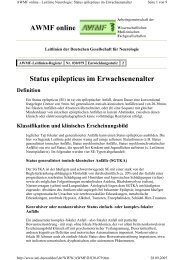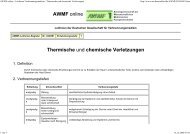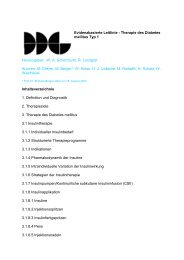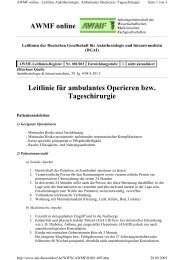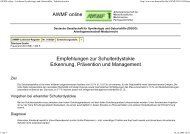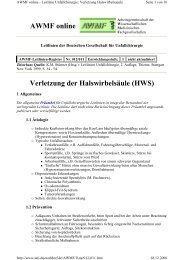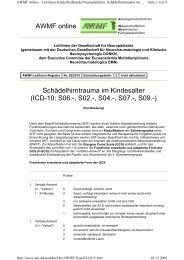Kreislaufstillstand unter besonderen Umständen ... - Reanitrain
Kreislaufstillstand unter besonderen Umständen ... - Reanitrain
Kreislaufstillstand unter besonderen Umständen ... - Reanitrain
Sie wollen auch ein ePaper? Erhöhen Sie die Reichweite Ihrer Titel.
YUMPU macht aus Druck-PDFs automatisch weboptimierte ePaper, die Google liebt.
486. Carbonne B, Benachi A, Leveque ML et al (1996)<br />
Maternal position during labor: effects on fetal<br />
oxygen saturation measured by pulse oximetry.<br />
Obstet Gynecol 88:797–800<br />
487. Tamas P, Szilagyi A, Jeges S et al (2007) Effects of<br />
maternal central hemodynamics on fetal heart rate<br />
patterns. Acta Obstet Gynecol Scand 86:711–<br />
714<br />
488. Abitbol MM (1985) Supine position in labor and<br />
associated fetal heart rate changes. Obstet Gynecol<br />
65:481–486<br />
489. Ellington C, Katz VL, Watson WJ, Spielman FJ<br />
(1991) The effect of lateral tilt on maternal and<br />
fetal hemodynamic variables. Obstet Gynecol<br />
77:201–203<br />
490. Matorras R, Tacuri C, Nieto A et al (1998) Lack of<br />
benefits of left tilt in emergent cesarean sections:<br />
a randomized study of cardiotocography, cord<br />
acid-base status and other parameters of the mother<br />
and the fetus. J Perinat Med 26:284–292<br />
491. Kinsella SM, Whitwam JG, Spencer JA (1990) Aortic<br />
compression by the uterus: identification with<br />
the Finapres digital arterial pressure instrument.<br />
Br J Obstet Gynaecol 97:700–705<br />
492. Kundra P, Khanna S, Habeebullah S, Ravishankar<br />
M (2007) Manual displacement of the uterus during<br />
Caesarean section. Anaesthesia 62:460–465<br />
493. Amaro A, Capelli E, Cardoso M et al (1998) Manual<br />
left uterine displacement or modified Crawford‟s<br />
edge. A comparative study in spinal anesthesia<br />
for cesarean delivery. Rev Bras Anestesiol 48:99–<br />
104<br />
494. Kinsella SM (2003) Lateral tilt for pregnant women:<br />
why 15 degrees? Anaesthesia 58:835–836<br />
495. Goodwin AP, Pearce AJ (1992) The human wedge.<br />
A manoeuvre to relieve aortocaval compression<br />
during resuscitation in late pregnancy. Anaesthesia<br />
47:433–434<br />
496. Rees GA, Willis BA (1988) Resuscitation in late<br />
pregnancy. Anaesthesia 43:347–349<br />
497. Jones SJ, Kinsella SM, Donald FA (2003) Comparison<br />
of measured and estimated angles of table tilt<br />
at Caesarean section. Br J Anaesth 90:86–87<br />
498. Johnson MD, Luppi CJ, Over DC (1998) Cardiopulmonary<br />
resuscitation. In: Gambling DR, Douglas<br />
MJ (Hrsg) Obstetric anesthesia and uncommon<br />
disorders. W. B. Saunders, Philadelphia, S 51–74<br />
499. Izci B, Vennelle M, Liston WA et al (2006) Sleepdisordered<br />
breathing and upper airway size in<br />
pregnancy and post-partum. Eur Respir J 27:321–<br />
327<br />
500. Rahman K, Jenkins JG (2005) Failed tracheal intubation<br />
in obstetrics: no more frequent but still<br />
managed badly. Anaesthesia 60:168–171<br />
501. Henderson JJ, Popat MT, Latto IP, Pearce AC (2004)<br />
Difficult Airway Society guidelines for management<br />
of the unanticipated difficult intubation.<br />
Anaesthesia 59:675–694<br />
502. Nanson J, Elcock D, Williams M, Deakin CD (2001)<br />
Do physiological changes in pregnancy change<br />
defibrillation energy requirements? Br J Anaesth<br />
87:237–239<br />
503. Potts M, Prata N, Sahin-Hodoglugil NN (2010) Maternal<br />
mortality: one death every 7 min. Lancet<br />
375:1762–1763<br />
504. Geoghegan J, Daniels JP, Moore PA et al (2009)<br />
Cell salvage at caesarean section: the need for an<br />
evidence-based approach. BJOG 116:743–747<br />
505. Bouwmeester FW, Bolte AC, Geijn HP van (2005)<br />
Pharmacological and surgical therapy for primary<br />
postpartum hemorrhage. Curr Pharm Des<br />
11:759–773<br />
506. Hofmeyr GJ, Abdel-Aleem H, Abdel-Aleem MA<br />
(2008) Uterine massage for preventing postpartum<br />
haemorrhage. Cochrane Database Syst Rev:<br />
CD006431<br />
507. Sekhavat L, Tabatabaii A, Dalili M et al (2009) Efficacy<br />
of tranexamic acid in reducing blood loss after<br />
cesarean section. J Matern Fetal Neonatal Med<br />
22:72–75<br />
508. Phillips LE, McLintock C, Pollock W et al (2009) Recombinant<br />
activated factor VII in obstetric hemorrhage:<br />
experiences from the Australian and<br />
New Zealand Haemostasis Registry. Anesth Analg<br />
109:1908–1915<br />
509. Bomken C, Mathai S, Biss T et al (2009) Recombinant<br />
Activated Factor VII (rFVIIa) in the management<br />
of major obstetric haemorrhage: A case series<br />
and a proposed guideline for use. Obstet Gynecol<br />
Int 2009:364843<br />
510. Doumouchtsis SK, Papageorghiou AT, Vernier C,<br />
Arulkumaran S (2008) Management of postpartum<br />
hemorrhage by uterine balloon tamponade:<br />
prospective evaluation of effectiveness. Acta Obstet<br />
Gynecol Scand 87:849–855<br />
511. Georgiou C (2009) Balloon tamponade in the management<br />
of postpartum haemorrhage: a review.<br />
BJOG 116:748–757<br />
512. El-Hamamy E, C BL (2005) A worldwide review of<br />
the uses of the uterine compression suture techniques<br />
as alternative to hysterectomy in the management<br />
of severe post-partum haemorrhage. J<br />
Obstet Gynaecol 25:143–149<br />
513. Hong TM, Tseng HS, Lee RC et al (2004) Uterine artery<br />
embolization: an effective treatment for intractable<br />
obstetric haemorrhage. Clin Radiol<br />
59:96–101<br />
514. Knight M (2007) Peripartum hysterectomy in the<br />
UK: management and outcomes of the associated<br />
haemorrhage. BJOG 114:1380–1387<br />
515. Rossi AC, Lee RH, Chmait RH (2010) Emergency<br />
postpartum hysterectomy for uncontrolled postpartum<br />
bleeding: a systematic review. Obstet Gynecol<br />
115:637–644<br />
516. Yu S, Pennisi JA, Moukhtar M, Friedman EA (1995)<br />
Placental abruption in association with advanced<br />
abdominal pregnancy. A case report. J Reprod<br />
Med 40:731–735<br />
517. Ray P, Murphy GJ, Shutt LE (2004) Recognition<br />
and management of maternal cardiac disease in<br />
pregnancy. Br J Anaesth 93:428–439<br />
518. Abbas AE, Lester SJ, Connolly H (2005) Pregnancy<br />
and the cardiovascular system. Int J Cardiol<br />
98:179–189<br />
519. James AH, Jamison MG, Biswas MS et al (2006)<br />
Acute myocardial infarction in pregnancy: a United<br />
States population-based study. Circulation<br />
113:1564–1571<br />
520. Ahearn GS, Hadjiliadis D, Govert JA, Tapson VF<br />
(2002) Massive pulmonary embolism during<br />
pregnancy successfully treated with recombinant<br />
tissue plasminogen activator: a case report<br />
and review of treatment options. Arch Intern Med<br />
162:1221–1227<br />
521. Drenthen W, Pieper PG, Roos-Hesselink JW et al<br />
(2007) Outcome of pregnancy in women with<br />
congenital heart disease: a literature review. J Am<br />
Coll Cardiol 49:2303–2311<br />
522. Sibai B, Dekker G, Kupferminc M (2005) Preeclampsia.<br />
Lancet 365:785–799<br />
523. Sibai BM (2005) Diagnosis, prevention, and management<br />
of eclampsia. Obstet Gynecol 105:402–<br />
410<br />
524. Duley L, Gulmezoglu AM, Henderson-Smart<br />
DJ (2003) Magnesium sulphate and other anticonvulsants<br />
for women with pre-eclampsia.<br />
Cochrane Database Syst Rev:CD000025<br />
525. Duley L, Henderson-Smart D (2003) Magnesium<br />
sulphate versus phenytoin for eclampsia.<br />
Cochrane Database Syst Rev:CD000128<br />
526. Duley L, Henderson-Smart D (2003) Magnesium<br />
sulphate versus diazepam for eclampsia.<br />
Cochrane Database Syst Rev:CD000127<br />
527. Knight M (2008) Antenatal pulmonary embolism:<br />
risk factors, management and outcomes. BJOG<br />
115:453–461<br />
528. Dapprich M, Boessenecker W (2002) Fibrinolysis<br />
with alteplase in a pregnant woman with stroke.<br />
Cerebrovasc Dis 13:290<br />
529. Turrentine MA, Braems G, Ramirez MM (1995) Use<br />
of thrombolytics for the treatment of thromboembolic<br />
disease during pregnancy. Obstet Gynecol<br />
Surv 50:534–541<br />
530. Thabut G, Thabut D, Myers RP et al (2002) Thrombolytic<br />
therapy of pulmonary embolism: a metaanalysis.<br />
J Am Coll Cardiol 40:1660–1667<br />
531. Patel RK, Fasan O, Arya R (2003) Thrombolysis in<br />
pregnancy. Thromb Haemost 90:1216–1217<br />
532. Conde-Agudelo A, Romero R (2009) Amniotic fluid<br />
embolism: an evidence-based review. Am J<br />
Obstet Gynecol 201:445 e1–e13<br />
533. Knight M, Tuffnell D, Brocklehurst P et al (2010) Incidence<br />
and risk factors for amniotic-fluid embolism.<br />
Obstet Gynecol 115:910–917<br />
534. Stanten RD, Iverson LI, Daugharty TM et al (2003)<br />
Amniotic fluid embolism causing catastrophic<br />
pulmonary vasoconstriction: diagnosis by transesophageal<br />
echocardiogram and treatment by cardiopulmonary<br />
bypass. Obstet Gynecol 102:496–<br />
498<br />
535. Katz VL, Dotters DJ, Droegemueller W (1986) Perimortem<br />
cesarean delivery. Obstet Gynecol<br />
68:571–576<br />
536. (o A) (2000) American Heart Association in collaboration<br />
with International Liaison Committee<br />
on Resuscitation. Guidelines 2000 for Cardiopulmonary<br />
Resuscitation and Emergency Cardiovascular<br />
Care. Circulation 102(Suppl):I1-I384<br />
537. Chapter 4; Part 6: Cardiac arrest associated with<br />
pregnancy. In: Cummins R, Hazinski M, Field J<br />
(Hrsg) ACLS-The reference textbook. Dallas: American<br />
Heart Association;2003:143–158<br />
538. Katz V, Balderston K, DeFreest M (2005) Perimortem<br />
cesarean delivery: were our assumptions correct?<br />
Am J Obstet Gynecol 192:1916–1920; discussion<br />
20–21<br />
539. Oates S, Williams GL, Rees GA (1988) Cardiopulmonary<br />
resuscitation in late pregnancy. BMJ 297:404–405<br />
540. Strong THJ, Lowe RA (1989) Perimortem cesarean<br />
section. Am J Emerg Med 7:489–494<br />
541. Boyd R, Teece S (2002) Towards evidence based<br />
emergency medicine: best BETs from the Manchester<br />
Royal Infirmary. Perimortem caesarean<br />
section. Emerg Med J 19:324–325<br />
542. Dijkman A, Huisman CM, Smit M et al (2010) Cardiac<br />
arrest in pregnancy: increasing use of perimortem<br />
caesarean section due to emergency<br />
skills training? BJOG 117:282–287<br />
543. Allen MC, Donohue PK, Dusman AE (1993) The limit<br />
of viability – neonatal outcome of infants<br />
born at 22 to 25 weeks‘ gestation. N Engl J Med<br />
329:1597–1601<br />
544. Moore C, Promes SB (2004) Ultrasound in pregnancy.<br />
Emerg Med Clin North Am 22:697–722<br />
545. Natale A, Davidson T, Geiger MJ, Newby K (1997) Implantable<br />
cardioverter-defibrillators and pregnancy:<br />
a safe combination? Circulation 96:2808–2812<br />
546. Siassakos D, Crofts JF, Winter C et al (2009) The active<br />
components of effective training in obstetric<br />
emergencies. BJOG 116:1028–1032<br />
Notfall + Rettungsmedizin 7 · 2010 |<br />
721



